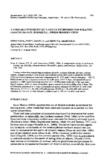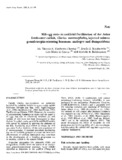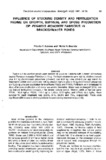| dc.contributor.author | Encena, V. C., II | |
| dc.contributor.author | Capinpin, Emmanuel C., Jr. | |
| dc.contributor.author | Bayona, N.C. | |
| dc.date.accessioned | 2013-11-16T03:38:43Z | |
| dc.date.available | 2013-11-16T03:38:43Z | |
| dc.date.issued | 1998 | |
| dc.identifier.citation | Encena II, V. C., Capinpin Jr., E. C., & Bayona, N. C. (1998). Optimal sperm concentration and time for fertilization of the tropical abalone, Haliotis asinina Linné 1758. Aquaculture, 165(3-4), 347-352. | en |
| dc.identifier.issn | 0044-8486 | |
| dc.identifier.uri | http://hdl.handle.net/10862/1739 | |
| dc.description.abstract | Current interest in the tropical abalone, Haliotis asinina has generated research into seed production and culture techniques. However, there has been no report regarding the optimal sperm concentration for fertilization and development, and gamete viability for this species. Spawned eggs of H. asinina were artificially fertilized using eleven final sperm concentrations ranging from 1×102 to 1×107 sperm ml−1. In another experiment, eggs were fertilized using sperm spawned at the same time at a final sperm concentration of 1×105 sperm ml−1 at 1, 2, 3, 4, and 5 h after spawning. Sperm concentrations of 5×103 to 1×105 sperm ml−1 gave both maximal fertilization rate and normal trochophore development. The sperm to oocyte ratio of this range is 1×103 to 2×104. Gametes were still viable 2 h after spawning; both fertilization and normal development rates decreased when fertilized later. It is recommended to use 1×105 sperm ml−1 for artificial fertilization of H. asinina eggs within 2 h after spawning. | en |
| dc.language.iso | en | en |
| dc.publisher | Elsevier | en |
| dc.subject | Haliotis asinina | en |
| dc.subject | Philippines | en |
| dc.subject | Tropical abalone | en |
| dc.subject | Sperm concentration | en |
| dc.subject | Artificial fertilization | en |
| dc.subject | Gamete viability | en |
| dc.title | Optimal sperm concentration and time for fertilization of the tropical abalone, Haliotis asinina Linné 1758 | en |
| dc.type | Article | en |
| dc.citation.volume | 165 | |
| dc.citation.issue | 3-4 | |
| dc.citation.spage | 347 | |
| dc.citation.epage | 352 | |
| dc.citation.journalTitle | Aquaculture | en |
| dc.subject.asfa | aquaculture techniques | en |
| dc.subject.asfa | fertilization | en |
| dc.subject.asfa | induced ovulation | en |
| dc.subject.asfa | mollusc culture | en |
| dc.subject.asfa | spawning | en |
| dc.subject.asfa | sperm | en |
| dc.subject.asfa | gametes | en |
| dc.identifier.doi | 10.1016/S0044-8486(98)00250-6 | |



